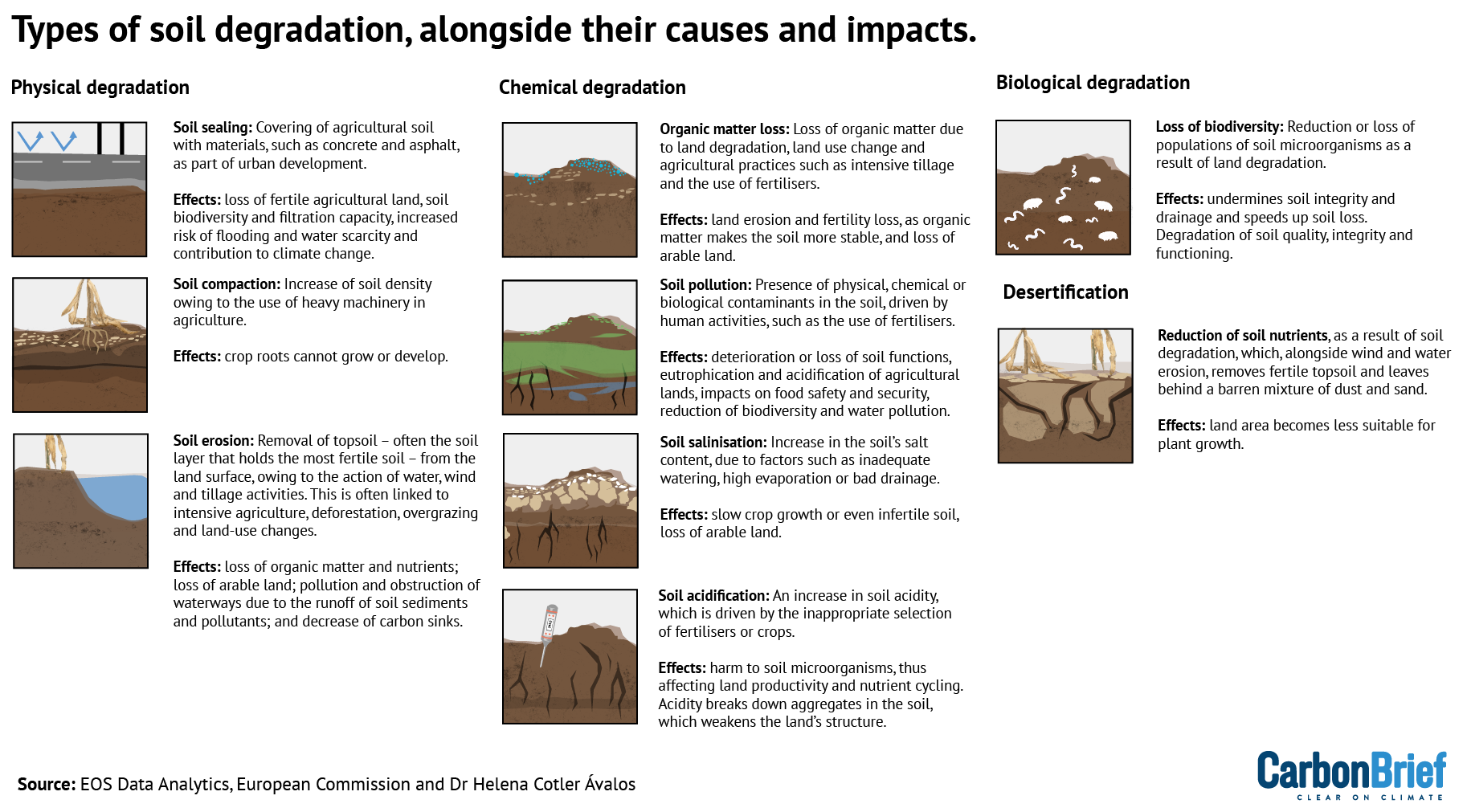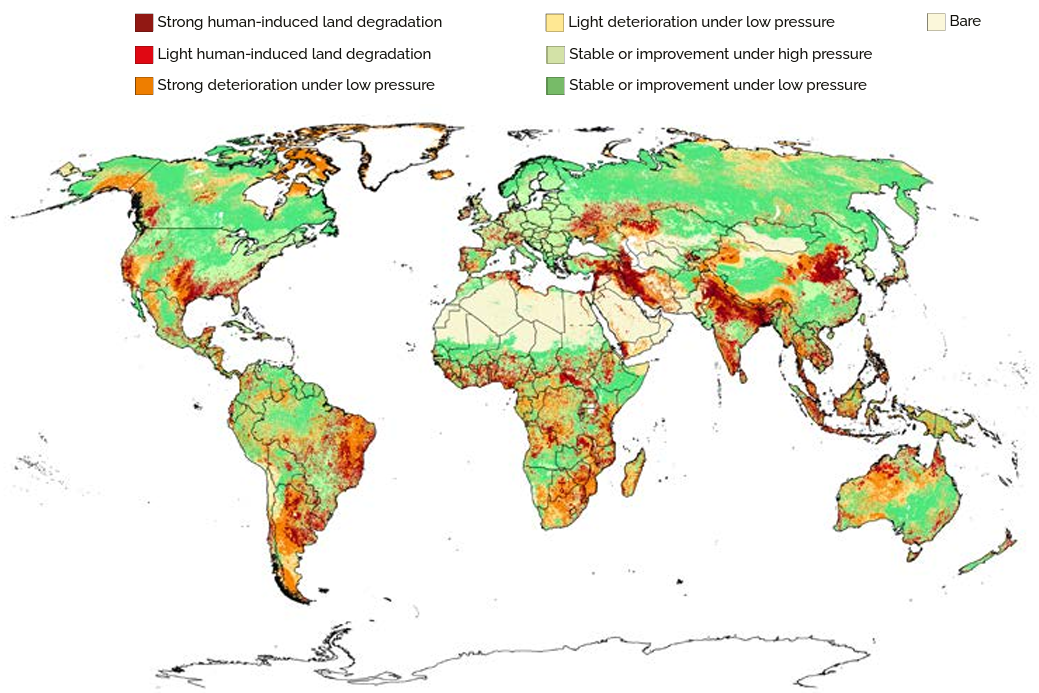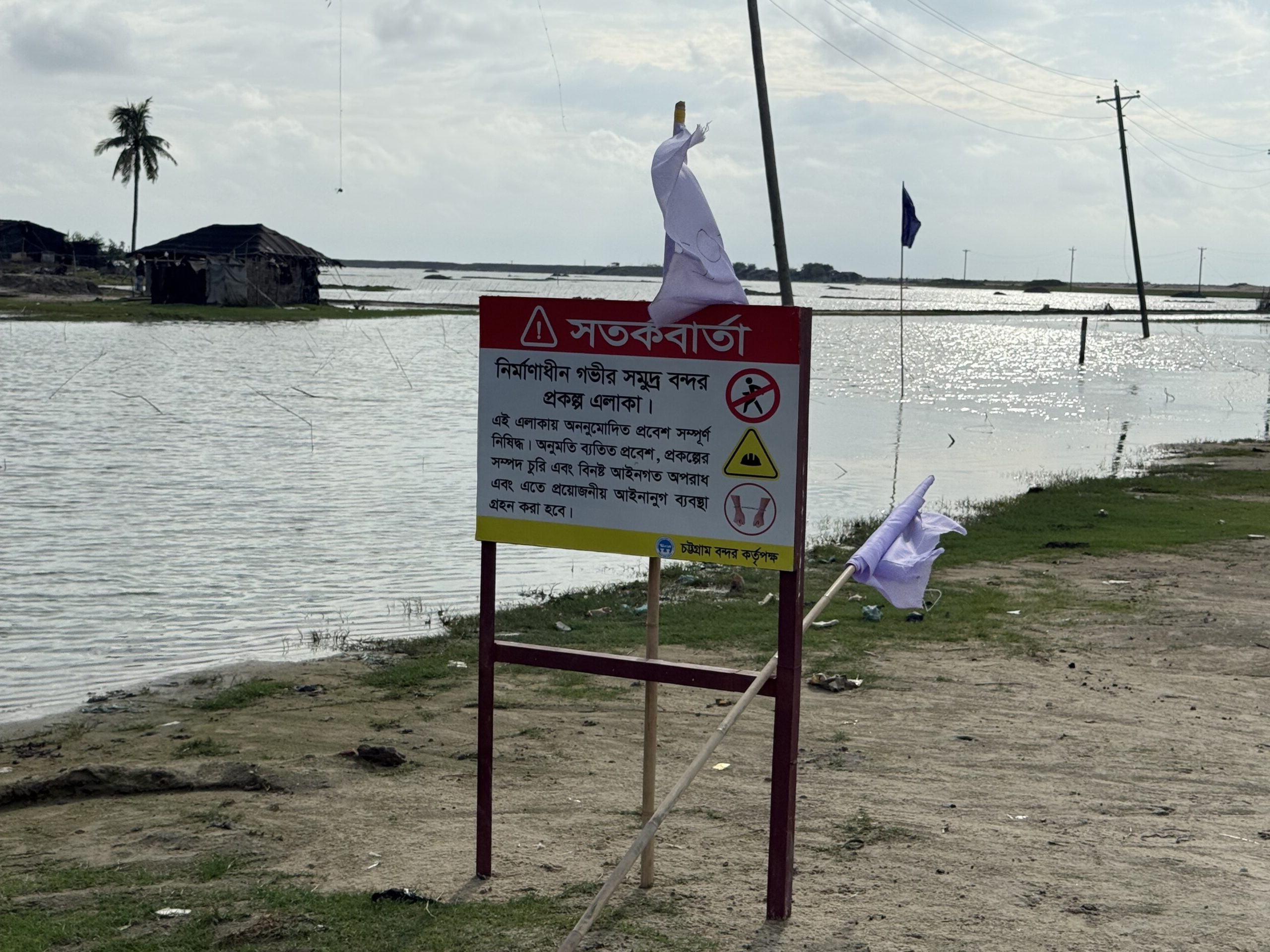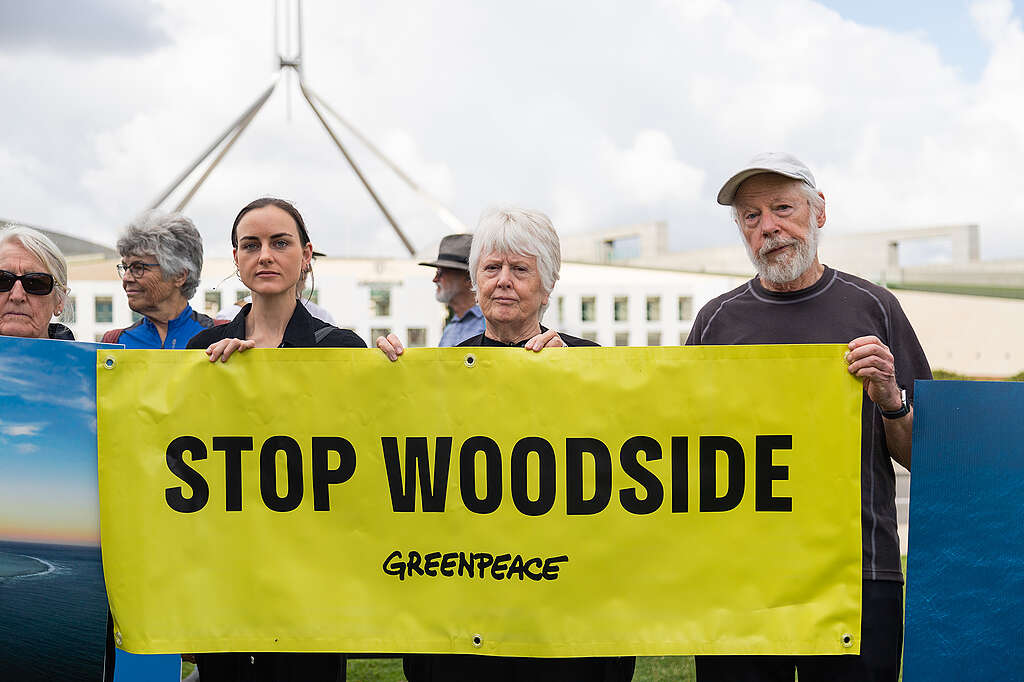Feeding the 8.2 billion people who inhabit the planet depends on healthy soils.
Yet, soil health has been declining over the years, with more than one-third of the world’s agricultural land now described by scientists as “degraded”.
Furthermore, the world’s soils have lost 133bn tonnes of carbon since the advent of agriculture around 12,000 years ago, with crop production and cattle grazing responsible in equal part.
As a result, since the early 1980s, some farmers have been implementing a range of practices aimed at improving soil fertility, soil structure and soil health to address this degradation.
Soil health is increasingly on the international agenda, with commitments made by various countries within the Global Biodiversity Framework, plus a declaration at COP28.
Yet, there is still a lack of knowledge about the state of soils, especially in developing countries.
Below, Carbon Brief explains the state of soil health across the world’s farmlands, the factors that lead to soil degradation and the potential solutions to regenerate agricultural soils.
- What is soil health?
- Why are agricultural soils being degraded?
- Why is soil health important for food security and climate mitigation?
- How can CO2 removal techniques improve soil carbon?
- How can agricultural soil be regenerated?
- What international policies promote soil health?
What is soil health?
Agricultural soil is composed of four layers, known as soil horizons. These layers contain varying quantities of minerals, organic matter, living organisms, air and water.
The upper layers of soil are rich in organic matter and soil organisms. This is where crops and plants thrive and where their roots can be found.
Below the topsoil is the subsoil, which is more stable and accumulates minerals such as clay due to the action of rain, which washes down these materials from the topsoil to deeper layers of the soil.
The subsoil often contains the roots of larger trees. The deeper layers include the substrate and bedrock, which consist of sediments and rocks and contain no organic matter or biological activity.
Soil organic matter consists of the remains of plants, animals and microbes. It supports the soil’s ability to capture water and prompts the growth of soil microorganisms, such as bacteria and fungi, says Dr Helena Cotler Ávalos, an agronomic engineer at the Geospatial Information Science Research Center in Mexico.
Some of these organisms can help roots find nutrients, even over long distances, while others transform nutrients into forms that plants can use. Cotler Ávalos tells Carbon Brief:
“Life in the soil always starts by introducing organic matter.”
Soil is typically classified into three types – clay, silt and sand – based on the size and density of the soil’s constituent parts, as well as the mineral composition of the soil. Porous, loamy soils – a combination of clay, silt and sand – are considered the most fertile type of soil. The mineral composition also influences the properties of the soil, such as colour.
Healthy soils contain three macronutrients – nitrogen, phosphorus and potassium – alongside a range of micronutrients. They also contain phytochemicals, which have antioxidant and anti-inflammatory properties and are important for human health.
Below is a graphic showing the elements that constitute healthy soils, including non-mineral elements such as hydrogen, carbon and oxygen (shown in green), according to the Nature Education Knowledge Project.

The concept of “soil health” recognises the role of soil not only in the production of biomass or food, but also in global ecosystems and human health. The Intergovernmental Technical Panel on Soils – a group of experts that provides scientific and technical advice on soil issues to the Global Soil Partnership at the UN Food and Agriculture Organization (FAO) – defines it as the “ability of the soil to sustain the productivity, diversity and environmental services of terrestrial ecosystems”.
Soils can sequester carbon when plants convert CO2 into organic compounds through photosynthesis, or when organic matter, such as dead plants or microorganisms, accumulate in the soil. Soils also provide other ecosystem services, such as improving air and water quality and contributing to biodiversity conservation.
Why are agricultural soils being degraded?
The term “soil degradation” means a decline in soil health, which reduces its ability to provide ecosystem services.
Currently, about 35% of the world’s agricultural land – approximately 1.66bn hectares – is degraded, according to the FAO.
Introduced during the Industrial Revolution, modern-era industrialised agriculture has spread to dominate food production in the US, Europe, China, Russia and beyond.
Modern modes of industrial agriculture employ farming practices that can be harmful to the soil. Examples include monocropping, where a single crop is grown repeatedly, over-tilling, where the soil is ploughed excessively, and the use of heavy machinery, pesticides and synthetic fertilisers.
Agricultural soils are also degraded by overgrazing, deforestation, contamination and erosion.
The diagram below depicts the different types of soil degradation: physical, chemical, biological and desertification.

Types of soil degradation, alongside their causes and impacts. Source: EOS Data Analytics, European Commission and Dr Helena Cotler Ávalos. Credit: Kerry Cleaver for Carbon Brief.
Industrial agriculture is responsible for 22% of global greenhouse gas emissions and also contributes to water pollution and biodiversity loss.
The map below, from the FAO, shows the state of land degradation around the world, from “strong” (dark red) to “stable or improv[ing]” (bright green).
It shows that the most degraded agricultural lands are in the southern US, eastern Brazil and Argentina, the Middle East, northern India and China.

Soil degradation became widespread following the Green Revolution in the 1940s, says Cotler Ávalos. During the Green Revolution, many countries replaced their traditional, diversified farming systems with monocultures. The Green Revolution also promoted the use of synthetic fertilisers and pesticides.
These changes led to a “dramatic increase” in yields, but also resulted in disrupting the interactions between microorganisms in the soil.
Cotler Ávalos tells Carbon Brief:
“It is the microorganisms that give life to soils. They require organic matter, which has been replaced by [synthetic] fertilisers.”
Today, there is a widespread lack of data on the condition of soils in developing countries.
For example, in sub-Saharan Africa, there are few studies measuring the rate and extent of soil degradation due to insufficient, reliable data. In Latin America, data on soil carbon dynamics are scarce.
Conversely, the EU released a report in 2024 about the state of its soils, spanning various indicators of degradation, including pollution, compaction and biodiversity change. The report estimates that 61% of agricultural soils in the EU are “degraded”, as measured by changes in organic carbon content, soil biodiversity and erosion levels.
The UK also has its own agricultural land classification maps, which classifies the condition of agricultural soils into categories ranging from “excellent” to “very poor”. This year, a report found that 40% of UK agricultural soils are degraded due to intensive agriculture.
Cotler Ávalos tells Carbon Brief:
“No country in the global south has data on how much of its soil is contaminated by agrochemicals, how much is compacted by the use of intensive machinery, how much has lost fertility due to the failure to incorporate organic matter.
“What is not studied, what is not known, seems to be unimportant. The problem of soil erosion is a social and political problem, not a technical one.”
Improved soil data, indicators and maps can help guide the sustainable management and regeneration of agricultural soils, experts tell Carbon Brief.
Why is soil health important for food security and climate mitigation?
As around 95% of the food the world consumes is produced, directly or indirectly, on soil, its health is crucial to global food security.
Food production needs to satisfy the demand of the global population, which is currently 8.2 billion and is expected to surpass 9 billion by 2037.
A 2023 review study pointed out that the total area of global arable land is estimated at 30m square kilometres, or 24% of the total land surface. Approximately half of that area is currently cultivated.
Studies have estimated that soil degradation has reduced food production by between 13% and 23%.
The 2023 review study also projected that land degradation could cut global food production by 12% in the next 25 years, increasing food prices by 30%.
Another recent study found that, between 2000 and 2016, healthy soils were associated with higher yields of rainfed corn in the US, even under drought conditions.
Research shows that soil health plays an important role in nutrition.
For example, a 2022 study found that a deficiency in plant nutrients in rice paddy soils in India is correlated with malnutrition. The country faces a growing amount of degraded land – currently spanning 29% of the total geographical area – and more than 15% of children are reported to suffer from deficiencies in vitamins A, B12 and D, along with folate and zinc, according to the study.
Soil health is also crucial for mitigating climate change.
Global agricultural lands store around 47bn tonnes of carbon, with trees contributing 75% of this total, according to a 2022 study.
Agricultural soils could sequester up to 4% of global greenhouse gas emissions annually and make a “significant contribution to reaching the Paris Agreement’s emissions reduction objectives”, according to a report from the Organisation for Economic Co-operation and Development (OECD).
Some farming practices can reduce greenhouse gas emissions and improve soil carbon sequestration, such as improving cropland and grazing land management, restoring degraded lands and cultivating perennial crops or “cover crops” that help reduce erosion.
However, some scientists have warned that the amount of carbon that can be captured in global soils – and how long that carbon remains locked away – has been overestimated.
For example, an article published in Science in 2023 argued that one of the widely used models for simulating the flow of carbon and nitrogen in soils, known as DayCent, has “plenty of shortcomings”. It says:
“It doesn’t explicitly represent how soils actually work, with billions of microbes feasting on plant carbon and respiring much of it back to the atmosphere – while converting some of it to mineralised forms that can stick around for centuries.
“Instead, the model estimates soil carbon gains and losses based on parameters tuned using published experimental results.”
That, along with uncertainties associated with small-scale estimations, makes the model unable to accurately predict increases or decreases of soil carbon over time and, thus, a positive or negative impact on the climate, the outlet said.
How can CO2 removal techniques improve soil carbon?
Soils can also play a role in mitigating climate change through the use of CO2 removal techniques, such as biochar and enhanced rock weathering.
Biochar is a carbon-rich material derived from the burning of organic matter, such as wood or crop residues, in an oxygen-free environment – a process known as pyrolysis.
Biochar can be added to soils to enhance soil health and agricultural productivity.
Due to its porous nature, biochar holds nutrients in the soil, improving soil fertility, water retention, microbial activity and soil structure.
The long-term application of biochar can bring a range of benefits, such as improving yields, reducing methane emissions and increasing soil organic carbon, according to recent research that analysed 438 studies from global croplands.
However, the study added that many factors – including soil properties, climate and management practices – influence the magnitude of these effects.

Dr Dinesh Panday, a soil scientist at the agricultural research not-for-profit Rodale Institute and an expert in biochar, tells Carbon Brief that biochar typically is applied when soils have low carbon or organic matter content.
He adds that this technique is currently being used mostly in growing high-value crops, such as tomatoes, lettuce and peppers. For staple crops, including rice, wheat and maize, the use of biochar is only at a research stage, he adds.
Enhanced rock weathering is a process where silicate rocks are crushed and added to soils. The rocks then react with CO2 in the atmosphere and produce carbonate minerals, storing carbon from the atmosphere in the soil.
In the US, enhanced weathering could potentially sequester between 0.16-0.30bn tonnes of CO2 per year by 2050, according to a 2025 study.
Panday says that both biochar and enhanced weathering are mostly practised in developed countries at the moment and both have their own benefits and impacts. One of the disadvantages of biochar, he says, is its high cost, as producing it requires dedicated pyrolysis devices and the use of fossil gas. One negative effect of enhanced rock weathering is that it may alter nutrient cycling processes in the soil.
A 2023 comment piece by researchers from the University of Science and Technology of China raised some criticisms of biochar application, including the resulting emissions of methane and nitrous oxide, the enrichment of organic contaminants and heavy metals, and the dispersion of small particulate matter that can be harmful to human health.
Scientists still question how much carbon-removal techniques, such as enhanced rock weathering, can store in agricultural soils and for how long.
How can agricultural soil be regenerated?
Many types of farming practices can help conserve soil health and fertility.
These practices include minimising external inputs, such as fertilisers and pesticides, reducing tillage, rotating crops, using mixed cropping-livestock farming systems, applying manure or compost and planting perennial crops.
Low- or no-till practices involve stopping the large-scale turning over of soils. Instead, farmers using these systems plant seeds through direct drilling techniques, which helps maintain soil biodiversity. A 2021 review study found that in the south-eastern US, reducing tillage enhanced soil health by improving soil organic carbon, nitrogen and inorganic nutrients.
Mixed farming systems, which integrate the cultivation of crops with livestock, have also been found to be beneficial to soil health.
A 2022 study compared a conventional maize-soya bean rotation and a diverse four-year cropping system of maize, soya bean, oat and alfalfa in the mid-western US. It found that, compared to the conventional farm, the diversified system had a 62% increase in soil microbial biomass and a 157% increase in soil carbon.
One of the aims of soil regeneration is to make agricultural soil as much like a natural soil as possible, says Dr Jim Harris, professor of environmental technology at the Cranfield Environment Centre in the UK.
Harris, who is an expert in soil and ecological restoration, says that regenerating soils involves restoring the ecological processes that were once replaced by chemical inputs, while maintaining the soil’s ability to grow crops.
For example, he says, using regenerative agricultural approaches, such as rotational grazing, can help increase soil organic matter and fungi populations.

Which soil regeneration actions will be most successful will depend on the soil type, the natural climatic zone in which a farm is located, the rainfall and temperature regimes and which crops are being cultivated, he adds.
To measure the results of soil regeneration, farmers need to establish a baseline by determining the initial condition of the soil, then assess indicators of soil health. These indicators range from physical indicators, such as root depth, to biological indicators, such as earthworm abundance and microbial biomass.
In Sweden, researchers analysed these indicators in 11 farms that applied regenerative practices either recently or over the past 30 years. They found that the farms with no tillage, integration of livestock and organic matter permanent cover had higher levels of vegetation density and root abundance. Such practices had positive impacts on soil health, according to the researchers.
Switching from conventional to regenerative agriculture may take a farmer five to 10 years, Harris says. This is because finding the variants of a crop that are most resistant to, say, drought and pests could take a “long time”, but, ultimately, farms will have “more stable yields”, he says.
Harris tells Carbon Brief:
“Where governments can really help [is] in providing farmers with funds that allow them to make that transition over a longer period of time.”
Research has found that transitioning towards regenerative agriculture has economic benefits for farmers.
For example, farmers in the northern US who used regenerative agriculture for maize cropping had “29% lower grain production, but 78% higher profits over traditional corn production systems”, according to a 2018 study. (The profit from regenerative farms is due to low seed and fertiliser consumption and higher income generated by grains and other products produced in regenerative corn fields, compared to farms that only grow corn conventionally.)
A 2022 review study found that regenerative farming practices applied in 10 temperate countries over a 15-year period increased soil organic carbon without reducing yields during that time.
Meanwhile, a 2024 study analysing 20 crop systems in North America found that maize and soya bean yields increased as the crop system diversified and rotated. For example, maize income rose by $200 per hectare in sites where rotation included annual crops, such as wheat and barley. Under the same conditions, soya bean income increased by $128 per hectare, the study found.
The study pointed out that crop rotation – one of the characteristics of regenerative agriculture – contributes to higher yields, thanks to the variety of crops with different traits that allow them to cope with different stressors, such as drought or pests.
However, other research has questioned whether regenerative soil practices can have benefits for both climate mitigation and crop production.
A 2025 study modelled greenhouse gas emissions and yields in crops through to the end of the century. It found that grass cover crops with no tillage reduced 32.6bn tonnes of CO2-equivalent emissions by 2050, but reduced crop yields by 4.8bn tonnes. The lowest production losses were associated with “modest” mitigation benefits, with just 4.4bn tonnes of CO2e emissions reduced, the study added.
The authors explained that the mitigation potential of cover crops and no tillage was lower than previous studies that overlooked certain factors, such as soil nitrous oxide, future climate change and yields. Moreover, they warned, carbon removal using regenerative farming methods risks the release of emissions back into the atmosphere, if soil management returns to unsustainable practices.
Several of the world’s largest agricultural companies, including General Mills, Cargill, Unilever, Mars and Mondelez, have committed to regenerative agriculture goals. Nestlé, for example, has said that it is implementing regenerative agriculture practices in its supply chain that have had “promising initial results”. It adds that “farmers, in many cases, stand to see an increase in crop yields and profits”. As a result, the firm says it is committed to sourcing 50% of its ingredients from farms implementing regenerative agriculture by 2030.
However, Trellis, a sustainability-focused organisation, cautioned that “these results should be taken somewhat sceptical[ly]”, as there is no set definition on what regenerative agriculture is and measurement of the results is “lacking”.
In some places, the regeneration or recovery of agricultural soils is still practised alongside farmers’ traditional knowledge.
Ricardo Romero is an agronomist and the managing director of the cooperative Las Cañadas – Cloud Forest, lying 1300m above sea level in Mexico’s Veracruz mountains. There, cloud forests sit between tropical rainforest and pine forests, in what Romero considers “a very small ecosystem globally”, optimal for coffee plantations.
His cooperative is located on land previously used for industrial cattle farming. Today, the land is used for agroecological production of coffee, agroforestry and reforestation. The workers in the cooperative are mostly peasants who take on production and use techniques to improve soil fertility that they have learned by doing.

Romero says the soils in his cooperative have improved and crop yields have been maintained thanks to the compost they produce. He tells Carbon Brief:
“We are still in the learning stage. We sort of aspire to achieve what cultures such as the Chinese, Koreans and Japanese did. They returned all their waste to the fields and their agriculture lasted 4,000 years without chemical or organic fertilisers”.
What international policies promote soil health?
Soil health and soil regeneration feature in four of the targets under the UN Sustainable Development Goals (SDGs).
(There are 169 targets under the SDGs that contain measurable indicators for assessing progress towards each of the 17 goals.)
For example, target 15.3 calls on countries to “restore degraded land and soil” and “strive to achieve a land-degradation neutral world”.
Soil health is increasingly being recognised in international negotiations under the UN Framework Convention on Climate Change (UNFCCC), UN Convention on Biological Diversity (UN CBD) and the UN Convention to Combat Desertification (UNCCD), says Katie McCoshan, senior partnerships and international engagement manager for the Food and Land Use Coalition (FOLU).
Each of these conventions has established its own work groups, declarations and frameworks around soil health in recent years.
Ideally, says McCoshan, action on soils should be integrated across the three different conventions, as well as in conversations around food and nutrition.
However, work across the three conventions remains siloed.
Currently, agriculture is formally addressed under the UNFCCC via the Sharm el-Sheikh joint work on implementation of climate action on agriculture and food security, a four-year work plan agreed at COP27 in 2022. This work group is meant to provide countries with technical support and facilitate collaboration and research.
The COP27 decision that created the Sharm el-Sheikh agriculture programme “recognised that soil and nutrient management practices and the optimal use of nutrients…lie at the core of climate-resilient, sustainable food production systems and can contribute to global food security”.
At COP28 in Dubai, the presidency announced the Emirates Declaration on Sustainable Agriculture, Resilient Food Systems and Climate Action. The 160 countries that signed the declaration committed to integrating agriculture and food systems into their nationally determined contributions, national adaptation plans and national biodiversity strategies and action plans (NBSAPs). The declaration also aims to enhance soil health, conserve and restore land.
Harris says the Emirates Declaration is a “great first step”, but adds that it will “take time to develop the precise on-the-ground mechanisms” to implement such policies in all countries, as “they are moving at different speeds”.
Within the UNFCCC process, soil has also featured in non-binding initiatives such as the 4 per 1000, adopted at COP21 in Paris. The initiative aims to increase the amount of carbon sequestered in the top 30-40cm of global agricultural soils by 0.4%, or four parts per thousand, per year.
The UNCCD COP16, which took place in 2024 in Saudi Arabia, delivered a decision to “encourage” countries to avoid, reduce and reverse soil degradation of agricultural lands and improve soil health.
Although COP16 did not deliver a legally binding framework to combat drought, it resulted in the creation of the Riyadh Global Drought Resilience Partnership, a global initiative integrated by countries, international organisations and other countries to allocate $12bn towards initiatives to restore degraded land and enhance resilience against drought.
The COP also resulted in the Riyadh Action Agenda, which aspires to conserve and restore 1.5bn hectares of degraded land globally by 2030.
Although soil health appears under both conventions, it is not included as formally in the UNFCCC as in the UNCCD – as in the latter there is a direct mandate for countries to address soil health and land restoration, McCoshan tells Carbon Brief.
Under the UNCCD, countries have to establish land degradation neutrality (LDN) targets by 2030. To date, more than 100 countries have set these targets.
Under the biodiversity convention, COP15 held in Montreal in 2022 delivered the Kunming-Montreal Global Biodiversity Framework (GBF), a set of goals and targets aiming to “halt and reverse” biodiversity loss by 2030. Under the framework, targets 10 and 11 reference sustainable management of agriculture through agroecological practices, and the conservation and restoration of soil health, respectively.
A recent study suggests that restoring 50% of global degraded croplands could avoid the emission of more than 20bn tonnes of CO2 equivalent by 2050, which would be comparable to five times the annual emissions from the land-use sector. It would also bring biodiversity benefits and contribute to target 10 of the GBF and to UNCCD COP16 recommendations, the study added.
McCoshan tells Carbon Brief:
“[All] the pledges are important and they hold countries accountable, but that alone isn’t what we need. We’ve got to get the financing right and co-create solutions with farmers, Indigenous people, youth, businesses and civil society as well.”
The post Q&A: The role of soil health in food security and tackling climate change appeared first on Carbon Brief.
Q&A: The role of soil health in food security and tackling climate change
Climate Change
A Home Energy Fair Offers a Counter Narrative to Cynicism About Climate Change
There are opportunities for local progress on climate, even when the federal government abdicates its role.
There is a long-running debate over the relative weights of individual and government responsibility in limiting the effects of climate change.
A Home Energy Fair Offers a Counter Narrative to Cynicism About Climate Change
Climate Change
Business-as-usual: Donors pour climate adaptation finance into big infrastructure, neglecting local needs
For years, fisherman Sami Uddin lived and worked on a small patch of coastal land in southeastern Bangladesh – until the site was earmarked for development including a new cyclone-resistant deep-sea port, funded by Japan in the name of climate change adaptation.
“The development is [meant to help us] all, but the reality is that it takes our homes, professions, and they are forcing us to be evicted from our village,” Uddin, 51, said close to the port site in Matarbari, adding that new fishing restrictions nearby have fuelled local people’s anger.
The deep-sea port – being built next door to a new coal-fired power plant, also financed by Japan – is a centrepiece of Bangladesh’s ambitions to develop a “Singapore-style” economic hub on its climate-vulnerable Bay of Bengal coastline, a low-lying belt of densely populated land, prone to deadly tropical cyclones and flooding.
Funded with a $726-million concessional loan, half of which was counted by Japan as climate adaptation finance, the port marks the biggest single climate adaptation project being funded by a wealthy country in 2023, according to an analysis by Climate Home News of the latest data compiled by the Organisation for Economic Co-operation and Development (OECD).
But like other foreign-funded projects classed as “climate adaptation”, Climate Home’s reporting raises questions about whether the port investment will help climate-vulnerable local communities cope with the effects of more extreme weather and rising seas.
Japan’s development agency said the resilience measures to protect the port are crucial to preventing economic shocks and the disruption of essential services in case of disasters, while some interventions could also keep local people safer when storms hit.
COP30 president warns of ‘dystopian scenario’
Climate adaptation is set to be a key theme at next month’s COP30 UN climate summit in Brazil, and calls are growing for rich nations to increase their support for projects to help developing countries that are bearing the brunt of worsening climate impacts.
COP30 president André Aranha Corrêa do Lago said last week that the UN talks should take concrete steps to help vulnerable people adapt to a warming world and avoid a “dystopian scenario” in which only the rich can afford to protect themselves from climate threats.
But with just a fraction of needs for adaptation funding currently being met, according to the latest UN estimates, climate campaigners told Climate Home News that mega-projects like Matarbari are not the best way to protect the world’s poorest people from climate change.
They are also sounding the alarm about how a lack of uniform reporting rules and poor transparency in the data give countries free rein over what they label as adaptation finance.
Some donors “cheat” by focusing more on inflating numbers than on delivering real impact, said John Nordbo, senior climate advisor at NGO CARE Denmark and co-author of the annual “Climate Finance Shadow Report”.
“They label large projects with little or no adaptation component as ‘climate finance’,” he told Climate Home News. “It’s misleading – and when exposed, it undermines trust in the entire global climate regime.”
The $363 million provided by Japan for the Matarbari port was counted as adaptation finance under official data used to measure whether donors are meeting their promises on climate finance made at UN talks. It accounted for an estimated 15% of Japan’s total contributions to climate adaptation in 2023 – the latest year for which data is available.


“No one must be left behind”
When, at COP26, Japan committed to doubling its assistance for adaptation to $14.8 billion in public and private finance by 2025, its then Prime Minister Fumio Kishida told fellow world leaders “no one must be left behind as we confront the issue of climate change”. He added that investments would focus on disaster risk reduction.
Japan said the delivery of that pledge was “on track” in its latest assessment report for the UN earlier this year.
But Climate Home’s analysis of the data from the OECD – the main body tracking global climate finance flows from industrialised nations – found that in 2023 Tokyo channelled at least a third of its bilateral adaptation finance into large-scale infrastructure projects and broad health programmes that lacked clear climate adaptation objectives.
It counted loans worth hundreds of millions of dollars for the construction of mass rapid transit in Jakarta and the rollout of universal health coverage in Egypt as adaptation finance, for example. It offered no explanation in project documents of how either initiative would strengthen resilience to climate impacts.
It also reported a $200-million grant to the global vaccine alliance, Gavi, to support its COVID-19 response as having “significant” relevance for climate adaptation. In an assessment of Gavi in 2024, the Multilateral Performance Network described as a “serious challenge” the fact that addressing climate change was not yet a core objective within the alliance’s strategy.
Md Shamsuddoha, a former climate negotiator for Bangladesh who now leads the Center for Participatory Research and Development, said Japan repackages “pure investment projects” for infrastructure development as climate finance to show it is meeting its commitments made under the UN climate regime.
“Japan should not do this, because that is no climate finance at all,” Shamsuddoha added.
Japan’s Ministry of Foreign Affairs and its overseas aid arm, the Japan International Cooperation Agency (JICA), were approached for comment on the adaptation relevance of these projects, but had not responded by the time of publication.
Roadbuilding and energy projects
Climate Home’s analysis found Japan was not alone among major donors in labelling funds for large transport and energy infrastructure projects, or broad health programmes, as bilateral climate adaptation finance, which tends to be provided in grant form or as highly concessional lending to the poorest nations.
France and South Korea have used a similar approach, according to our analysis of the data from the OECD.
The three countries’ bilateral funding for those projects totalled at least $4 billion in 2023, but South Korea and France do not disclose the exact portion they have counted as climate adaptation finance.
According to the OECD data, France described loans provided for energy projects in developing countries as having a primary objective of adaptation, without giving a clear explanation of how they would boost climate resilience. They include strengthening electricity grids in Pakistan and Argentina, a hydropower plant in Tanzania and work to develop decarbonisation plans in Uzbekistan.
South Korea is not part of the group of developed countries under the UN climate regime and is therefore not obliged to provide climate finance to poor nations. But, in recent years, the country – one of the world’s largest economies – has hailed its “significant” support to the Global South for climate adaptation interventions.
Transport projects made up a significant portion of South Korea’s adaptation spending in developing countries in 2023. It counted the construction of a railway bridge in Bangladesh, a major highway in Vietnam and road networks in Cambodia and the Philippines among its top adaptation projects.
Hanna Hakko, a senior policy advisor at think-tank E3G, said developing countries have a critical need to build new resilient infrastructure and climate-proof what they already have.
“However, there is a need for clarity and guardrails around what counts as resilient infrastructure and to ensure impacted communities benefit from these projects and environmental impacts are minimised,” she added.
The climate ministries of South Korea and France had not responded to Climate Home’s request for clarifications on their adaptation finance at the time of publication.
Limited transparency in reporting system
Other donor governments such as Denmark, Switzerland and Finland take a more conservative approach, only counting pure climate adaptation activities or funding donated as grants in their spending.
But limited transparency in the reporting system makes it difficult to tell how much money overall is directed at efforts that truly help the most vulnerable communities to better cope with the escalating impacts of climate change.
Countries disclose brief and vague descriptions of the projects, often failing to offer details on their relevance for climate adaptation, Climate Home found.
Foreign aid cuts put adaptation finance pledge at risk, NGOs warn
Some European countries, including Germany, France and Italy, did not even identify a specific project or recipient nation for non-concessional funding worth hundreds of millions of dollars that was tagged as adaptation finance.
Ian Mitchell, a senior policy fellow at the Center for Global Development, said the problem lies with setting international goals to provide a certain amount of finance without a broadly agreed definition of what that finance can consist of.
“It is a pretty damaging state of affairs because these agreements are reached to motivate other countries to undertake climate action,” he added.
Focus on plugging adaptation gap
At the COP26 climate summit in Glasgow four years ago, developed countries committed to doubling adaptation funding for developing nations from 2019 levels to reach at least $40 billion by 2025.
That promise now looks set to be broken. According to the latest UN Environment Programme Adaptation Gap Report, international public adaptation funding from wealthy governments stood at only $26 billion in 2023 – falling slightly from the previous year.
UNEP’s report, released on Wednesday, warns that this year’s target “will be missed if current trends continue”.
Since 2023, widespread cuts to aid budgets amid geopolitical tensions and fiscal pressures have likely put the Glasgow goal further out of reach. Least-developed countries (LDCs), meanwhile, are pushing for a new goal to be set at COP30 to boost adaptation finance to about $100 billion a year by 2030.
Brazil’s COP presidency also wants to elevate climate adaptation, which has long missed out on political attention and funding directed instead to efforts to cut greenhouse gas emissions.
The renewed focus on adaptation in Belém could also increase scrutiny of how donor countries are allocating climate finance in countries like Bangladesh, and whose interests they are serving.
Climate-friendly coal plant?
Japan’s investments in Matarbari, for example, come as the country seeks to develop its economic ties with Bangladesh and counter China’s growing influence in the region.
Even the 1,200-megawatt coal-fired power plant, which JICA has financed with loans worth more than $2 billion, was counted by Japan as climate finance. It said the technology installed by Japanese firms made the plant more efficient, leading to a reduction in emissions compared to a conventional station.
The plant is expected to spew into the atmosphere nearly 7 million tonnes of carbon dioxide a year – equivalent to the total annual emissions generated by a small country like Mauritius.
As ships needed to deliver coal to fuel the plant, the developers built a port and a navigation channel connecting it to the ocean. Those facilities are now being expanded with the construction of the neighbouring deep-sea commercial port, which Japan agreed to fund in 2023 with a $726-million concessional loan.
Expected to be completed in 2029 by Japanese companies, the project aims to increase Bangladesh’s ability to handle cargo and spur economic activity in the area.
Takahiro Okamoto, who oversees the project at JICA’s Bangladesh office, said the inclusion of protections, like breakwaters, retaining walls and raised embankments, will shield the port and its access road from the impact of storm surges and cyclones.
“By allowing larger, more efficient ships to dock directly, the project reduces the country’s reliance on smaller, vulnerable ports and trans-shipment hubs in other countries, which might be more susceptible to disruptions from climate change and other factors,” Okamoto added.
Loss of salt and shrimp farms
Amid the bustle of construction activity, local residents in the area were sceptical about whether the development will make them better prepared for tidal surges or more frequent and severe storms.
Even if it does, they said the cost to their communities has been too high.
Over a third of the salt and shrimp farms in the area would be lost as a result of the construction, an impact assessment carried out by JICA found, adding that the mega-project would affect an area inhabited by almost 800,000 people.


Habibur Rahman, an unemployed 24-year-old man, said the development was not offering stable job opportunities for locals, while the coal power plant was causing growing pollution and damaging fishing activities.
“The [port] authority did not take a single project to develop our lives,” Rahman said.
Chittagong Port Authority and the Shipping Ministry did not reply to requests for comment.
JICA’s Okamoto said contractors are encouraged to employ local residents “as much as possible”, while 500 people have so far been trained under a programme that supports alternative income-generating activities.
He added that embankments built along the access road to the port to protect it would also serve as evacuation routes in disasters and that further protective measures may be considered as part of a separate plan being worked on by the Bangladesh government.
In the meantime, rising sea levels and stronger tidal flooding continue to chip away at the coast and swallow homes in the area, local media have reported.
“In no way [is] this an adaptation or resilience project,” Shamsuddoha said of the Matarbari development, saying it did not represent “resilient livelihoods” that would support coastal communities.
While developed countries pour their money into headline climate investment projects, the human dimension of adaptation is “completely missing”, he added.
The post Business-as-usual: Donors pour climate adaptation finance into big infrastructure, neglecting local needs appeared first on Climate Home News.
Climate Change
Why indirect fossil fuel lobbying is everybody’s problem and big brands must be held accountable
Lately I’ve been speaking with a lot of big companies and universities as part of Greenpeace’s gas campaign.
We’re urging brands like Telstra, Bupa, Woolworths, UTS, NAB and more to cancel their membership of the Business Council of Australia (BCA) – a powerful lobby group that’s been advocating for more dirty gas projects on their behalf.
Greenpeace is focused on these brands because they all claim to care about climate action and have made strong individual commitments to decarbonise their businesses. As a company committed to reducing emissions, you’d think that fossil fuel lobbying is counterproductive to those efforts – right?
These companies don’t think so. What I hear in meeting after meeting is a version of “that’s not my problem.”
But fossil fuel lobbying is their problem – and not just because it destroys their credibility on climate. Direct or indirect lobbying can bring legal, investor, reputational, and governance risk that companies need to be taking seriously.
Why indirect lobbying matters: the political influence of Industry Associations

Direct lobbying is when a corporation goes directly to the government, or whoever they are trying to influence and pushes their views. Indirect lobbying is when a corporation pays to be part of an Industry Association (also known as a peak body) which will do that lobbying on its behalf.
For a company, indirect lobbying via an Industry Association is often more influential than their own direct lobbying. Industry Associations like the BCA and Australian Energy Producers (AEP) have a big impact on shaping policy, through directly lobbying the government, being active in the media and advertising, and making political donations. Indeed this influence is the key reason why companies choose to become members in the first place – because they recognise that by presenting as a united voice, they can get more done than lobbying as one company.
When the BCA or AEP speak – the government listens. Prime Minister Albanese gave the keynote address at the BCA’s annual gala dinner earlier this year. And these groups are amongst the first to be consulted and receive briefings when the government is designing policy.
Examples of times industry association lobbying shaped government policy:
- Both the AEP and BCA made submissions to the government consultation on the Future Gas Strategy – with their key demands and narratives showing up many times in the government’s final strategy. This is the document setting the direction for the role of gas in Australia’s energy mix out to 2050 and beyond, but it reads more like Woodside’s Strategic Plan.
- The BCA and AEP were vocal advocates for the approval of Woodside’s North West Shelf Extension – arguing, in spite of their commitments to the Paris Agreement, that we need more gas. Not long after, the government approved the project.
- The BCA lobbied the government around the setting of its emissions reductions targets, arguing that a more ambitious target would cost too much. The government soon announced a weak target – far below what the science says is required to meet our international climate targets.
The BCA and AEP gain power from the fact that they claim to represent over a hundred large businesses, acting as spokespeople for their collective interests. The BCA and AEP rely on the brand recognition and reputation of their member companies, and in turn those companies benefit by having their views represented in parliament and the media.
Companies like Telstra, Commonwealth Bank and others may choose to look the other way – but refusing to acknowledge a problem doesn’t make it go away.

Legal risk of indirect lobbying that is misaligned with a company’s own climate commitments
When companies tell their customers and investors they have certain policies on climate change, it is their responsibility to ensure that their actions match the commitments they have made on paper.
So when a company says it is committed to the Paris Agreement, but then is part of an industry association which is lobbying for policies that are incompatible with the goals of the Paris Agreement, that could amount to what is known in legal terms as “misleading and deceptive conduct”. There is also a legal risk for board directors, who often don’t have oversight over what indirect fossil fuel lobbying a company is engaged in.
A specific example of this is the BCA and AEP’s lobbying for further gas expansion, when there is scientific consensus that expanding fossil fuels is incompatible with the goal of limiting warming to below 1.5C. As stated in this Climate Integrity report:
The “net zero by 2050” target is based upon the need to limit warming below 1.5°C to prevent further tipping points from being reached and then maintaining that temperature. Any net zero pledge that undermines this 1.5°C limit is self-contradictory and could in certain circumstances be viewed as misleading
In the eyes of the law, this applies not just to a company’s individual climate commitments – but also its indirect lobbying activities.
Investor risk of misaligned corporate lobbying

The Australasian Centre for Corporate Responsibility (ACCR) has outlined in depth the risks posed to a company’s investors from advocating on climate policy that is out of alignment with a company’s own policies and commercial interests.
Companies pay steep membership fees to be part of groups like the BCA and AEP. AGL for example paid $104,500 for its BCA membership in 2024. It could be considered a misuse of shareholder funds for a company to be a paying member of an industry association which does not represent its stated interests. In recent years investors have been doing more to hold companies to account for the activities of their industry associations.
In a report from over 5 years ago, ACCR explicitly identifies the core of the issue that still persists today:
There is often a significant difference between the formal policies of an industry association and the public advocacy that it undertakes. The most common example of this is companies that endorse the Paris Agreement while advocating for policies that are simply irreconcilable with its central objective: limiting global warming to 2ºC above pre-industrial temperatures. It is this fundamental disparity between policy and advocacy that poses the single largest risk to investors.
Companies that are part of these groups must take responsibility for their industry association lobbying that is out of alignment with the Paris Agreement and take note of the risks posed to investors.
What can you do to hold these brands accountable for their fossil fuel lobbying?
If you’re a member of the public:
- Greenpeace has created a Climate Credibility Scorecard, where we’ve ranked some of the most influential BCA members with strong climate commitments on what steps they’ve taken to distance themselves from the BCA’s lobbying for more dirty gas. This is a live resource that we’ll keep updating and adding more companies to, so keep checking back!
- You can email the CEOs of these companies using our easy tool and increase the pressure on them to act.
- Leave a message for Telstra’s leadership team here and urge them to quit the BCA. And help amplify our message on social media.
If you’re an employee of a company who is indirectly lobbying for fossil fuels:
- Check out this briefing for Telstra employees here (but the same tips apply to any company or university that is in the BCA or AEP!)
If you’re a member of an organisation or company considering partnering with one of these companies:
- Don’t take sponsorships from or offer speaking slots to companies in the BCA and AEP who aren’t walking the talk on climate. Prove that their reputation on climate is on the line.
The science is crystal clear: we can’t approve any new coal or gas projects if we want to avoid catastrophic climate impacts and limit global warming to 1.5C. We’re already feeling the impacts of climate change here in Australia and around the world – and the recent Climate Risk Assessment demonstrates just how bad things could get if we don’t urgently slash pollution from coal and gas now.
Until companies start actually taking responsibility for their fossil fuel lobbying – individual decarbonisation goals just aren’t going to cut it.
Will you join us and help hold these big brands to account?
Why indirect fossil fuel lobbying is everybody’s problem and big brands must be held accountable
-
Climate Change2 years ago
Spanish-language misinformation on renewable energy spreads online, report shows
-
Climate Change3 months ago
Guest post: Why China is still building new coal – and when it might stop
-
Climate Change Videos2 years ago
The toxic gas flares fuelling Nigeria’s climate change – BBC News
-

 Greenhouse Gases1 year ago
Greenhouse Gases1 year ago嘉宾来稿:满足中国增长的用电需求 光伏加储能“比新建煤电更实惠”
-
Greenhouse Gases3 months ago
Guest post: Why China is still building new coal – and when it might stop
-

 Climate Change1 year ago
Climate Change1 year ago嘉宾来稿:满足中国增长的用电需求 光伏加储能“比新建煤电更实惠”
-

 Carbon Footprint2 years ago
Carbon Footprint2 years agoUS SEC’s Climate Disclosure Rules Spur Renewed Interest in Carbon Credits
-
Renewable Energy4 months ago
US Grid Strain, Possible Allete Sale








